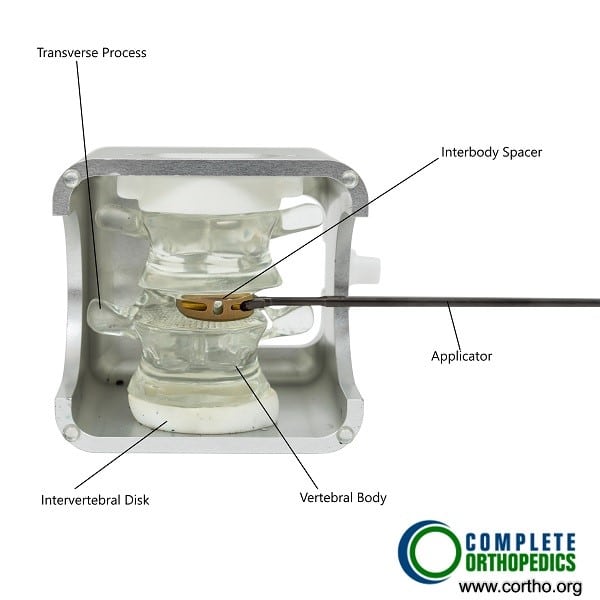Extreme Lateral Interbody Fusion
If spine discomfort worsens, interferes with daily routines, or accompanies inflammation and reddening, consulting a healthcare professional is crucial. At Complete Orthopedics, our expert team specializes in addressing spine ailments through tailored treatment strategies and surgical interventions. We prioritize comprehending your symptoms, pinpointing their origins, and suggesting the most suitable therapies or surgical procedures.
Conveniently situated across New York City and Long Island, our clinics are affiliated with six prominent hospitals, ensuring superior care for spine-related issues. Schedule an appointment with one of our orthopedic surgeons via our online platform or phone. Explore the underlying causes and remedies for spine discomfort, and learn about the circumstances warranting surgical intervention.
Overview
Extreme lateral or direct lateral interbody fusion is a surgical technique performed from the side of the body for the management of lumbar spine disease. The technique offers significant advantages over the traditional approach and is used to treat a wide range of diseases such as spondylolisthesis, disc herniation, etc.
Lumbar interbody fusion surgery is a surgical technique used to fuse the two diseased vertebrae together. The intervening intervertebral disk is removed during the surgery. The fusion of the vertebrae is achieved by using a bone graft which heals to form a solid bony bridge between the vertebrae. A cage made of polyethylene or metal alloy is inserted in between the vertebrae to maintain the disc height and decompress the neural structures. During the surgery any structures impinging upon the dural sac/spinal nerves are also removed.

Bone Model showing XLIF.
Traditionally, the surgery is performed from the back or the front of the spine. In posterior lumbar interbody fusion (PLIF) the surgeon gives an incision in the back of the spine and gains access to the intervertebral disc by carefully cutting structures. Similarly in anterior lumbar interbody fusion (ALIF), the surgeon gains access to the lumbar spine through an incision in the abdomen and by carefully retracting the abdominal organs and major blood vessels.
Procedure Overview
Extreme lateral interbody fusion (XLIF) on the other hand utilizes an incision from the side of the body. The spine surgeon uses two small incisions in the flanks and guides the instruments through the hole. Instead of cutting, the surgeon uses a tubular dilator that separates the tissues.
Upon reaching the diseased segment, the surgeon uses special instruments to remove the intervertebral disc. Any tissues impinging upon the dural sac/nerves are also removed to decompress the neural structures. The surgeon then introduces a cage to maintain the disc height and further decompress the segment. The cage is filled with bone graft material. Additional screws, rods or plates may be used to provide stability to the fusion construct.

Instruments used in XLIF and Interbody spacer.
The positions of implants and bone cage are confirmed on an intraoperative X-ray and the incisions are closed in layers. As the procedure involves less cutting and safer approach, the entire procedure takes significantly less time than the traditional approaches.
Through the lateral approach, the cutting of the sensitive back muscles is avoided as done in the posterior approach. Similarly there is no cutting and manipulation of ligaments, nerves, dural sac, etc during the lateral approach. This results in reduced post operative pain and reduced risk of inadvertent injury to the nerves and the dural sac. The patients report a faster rehabilitation as healing time is reduced secondary to less cutting of tissues.
Similarly, the lateral approach leads to less risk of injury to the abdominal organs and the major blood vessels as compared to the anterior approach. The risk of excessive bleeding is reduced and the patients rapidly return to their normal activity. There is also minimum scarring of the tissues as compared to the traditional approach.
Patient Considerations
Ideal Candidates
XLIF is particularly beneficial for patients with:
- Degenerative Disc Disease: Those experiencing chronic back pain and reduced mobility due to disc degeneration.
- Spinal Stenosis: Patients with nerve compression caused by the narrowing of the spinal canal.
- Spondylolisthesis: Individuals with vertebral slippage requiring stabilization.
- Scoliosis: Adults with spinal curvature affecting their quality of life.
The XLIF procedure may be performed in patients requiring interbody fusion of the lumbar spine above the L5-S1 level. The various conditions that may be treated are herniated intervertebral disc, mild spondylolisthesis, degenerative disc disease with instability, post-laminectomy instability, failure of lumbar disc replacement, etc.
The attending orthopaedic spine surgeon determined if the patient is a right candidate for extreme lateral interbody fusion. The surgeon extracts a thorough history of the events preceding the symptoms and performs a physical examination. Radiological tests are done to look for both the bony and the soft tissue structures of the spine.
Patients with lumbar disease of the L5-S1 segment and in some cases L4-L5 segments are not good candidates for XLIF. Also in patients with morbid obesity, infection, osteoporosis, and significant deformity and spondylolisthesis, XLIF is not indicated.
Risks and Complications
Like any surgical procedure, XLIF carries potential risks and complications:
- Nerve Injury: The lateral approach involves navigating through muscles close to major nerves, posing a risk of nerve damage.
- Infection: As with all surgeries, there is a risk of infection.
- Hardware Failure: In rare cases, the implanted cage or screws may fail, necessitating additional surgery.
- Persistent Pain: Some patients may continue to experience pain after the procedure.
As with any spine surgery, there may be potential complications such as blood clots, infection, excessive bleeding, inadequate fusion, nonunion of fusion, blood vessel/nerve damage, etc. The risk and complications are less as compared to the traditional approaches and a vast majority of patients benefit from the reduced operative time and a faster recovery period.
Postoperative Care
Pain Management
Effective pain management strategies, including medications and physical therapy, are crucial for a successful recovery. Pain control helps patients participate in rehabilitation activities essential for regaining strength and mobility.
Rehabilitation
A structured rehabilitation program tailored to the patient’s needs is vital. This program typically includes physical therapy exercises designed to enhance strength, flexibility, and spinal stability.
Follow-Up
Regular follow-up appointments are critical to monitor the healing process and address any complications early. These appointments often include physical assessments and imaging studies to evaluate the success of the fusion and the overall health of the spine.
Conclusion
Extreme Lateral Interbody Fusion (XLIF) represents a significant advancement in the field of spinal surgery, offering a minimally invasive option for treating various lumbar spine conditions. The lateral approach minimizes tissue disruption, reduces recovery times, and improves clinical outcomes. Patients experience significant improvements in pain relief and functional ability, making XLIF a highly effective and attractive option for those suffering from debilitating spine conditions.
Do you have more questions?
How does XLIF differ from traditional spinal fusion techniques?
XLIF accesses the spine laterally, whereas traditional techniques access it from the back (posterior) or front (anterior). This lateral approach minimizes muscle dissection, resulting in less postoperative pain and faster recovery.
What are the main benefits of XLIF compared to traditional approaches?
XLIF offers minimally invasive access, reduced muscle dissection, shorter hospital stays, and improved outcomes in pain relief and functional recovery.
What preoperative evaluations are necessary before undergoing XLIF?
Comprehensive evaluations including imaging studies like MRI and CT scans are necessary to accurately identify the spinal pathology, aiding in precise surgical planning.
Can XLIF be used to treat all types of spinal disorders, or are there specific conditions it’s most effective for?
XLIF is particularly effective for conditions like degenerative disc disease, spinal stenosis, spondylolisthesis, and scoliosis in the lumbar spine, but it may not be suitable for all spinal disorders.
How is anesthesia administered during XLIF, and why is the patient positioned on their side?
General anesthesia is administered, and the patient is positioned on their side to expose the flank area for the lateral surgical approach.
What are the key steps involved in the XLIF procedure?
The procedure involves making a small incision, navigating through the psoas muscle to reach the targeted intervertebral disc, removing the degenerated disc, inserting an interbody cage filled with bone graft material, and potentially using posterior fixation for spinal stability.
Is XLIF always performed as a standalone procedure, or are there cases where additional fixation is necessary?
While XLIF can provide primary stability with the interbody cage, additional posterior fixation with rods and screws may be used in some cases to enhance spinal stability.
What are the potential risks and complications associated with XLIF surgery?
Risks include nerve injury, infection, hardware failure, and persistent pain.
Are there any specific postoperative care instructions that patients need to follow after XLIF?
Postoperative care includes effective pain management, structured rehabilitation programs, and regular follow-up appointments for monitoring healing and addressing complications.
How long does it typically take to recover from XLIF surgery?
Recovery times vary, but patients often experience quicker recovery and shorter hospital stays compared to traditional spinal fusion surgeries.
Can XLIF be performed on patients who have had previous spine surgeries?
XLIF can be performed on select patients who have had previous spine surgeries, but careful evaluation is necessary to assess suitability.
What are the differences in recovery time between XLIF and traditional spinal fusion techniques?
Recovery from XLIF is typically quicker due to its minimally invasive nature and reduced tissue disruption.
How does XLIF compare in terms of long-term outcomes, such as fusion rates, with traditional approaches?
XLIF has shown comparable or improved long-term outcomes, including fusion rates, compared to traditional approaches in clinical studies.
Are there any limitations or contraindications to undergoing XLIF?
XLIF may not be suitable for all patients, particularly those with certain anatomical limitations or medical conditions.
How soon after surgery can patients expect to experience pain relief?
Many patients report immediate pain relief or significant improvement shortly after XLIF surgery.
What type of rehabilitation program is recommended following XLIF surgery?
Rehabilitation typically includes physical therapy exercises aimed at enhancing strength, flexibility, and spinal stability.
What factors determine whether a patient is a suitable candidate for XLIF?
Factors such as the specific spinal pathology, overall health, and anatomical considerations determine suitability for XLIF.
Are there any age restrictions for undergoing XLIF?
There are typically no strict age restrictions, but suitability for surgery is assessed on a case-by-case basis.
What advancements in surgical technology have improved the XLIF procedure?
Advancements include improved imaging and navigation systems, as well as advancements in biological materials for bone grafting.
How does XLIF compare to other minimally invasive spinal fusion techniques, such as TLIF or DLIF?
XLIF offers unique advantages such as lateral access and reduced muscle dissection compared to other minimally invasive techniques.
What ongoing research is being conducted to further improve XLIF outcomes and expand its indications?
Research focuses on refining surgical techniques, enhancing fusion rates, and expanding the indications for XLIF to include more complex spinal pathologies.

Dr. Suhirad Khokhar
My name is Dr. Suhirad Khokhar, and am an orthopaedic surgeon. I completed my MBBS (Bachelor of Medicine & Bachelor of Surgery) at Govt. Medical College, Patiala, India.
I specialize in musculoskeletal disorders and their management, and have personally approved of and written this content.
My profile page has all of my educational information, work experience, and all the pages on this site that I've contributed to.
